Journalist Report – April 16th
Today, two Extra-Vehicular Activities (EVAs) were conducted.
The first EVA took place in Condor Chasma and was primarily aimed at collecting soil samples for Bérengère (GreenHab Officer) as part of her ongoing microbiological experiment. The mission went smoothly under favorable weather conditions.
The second EVA, conducted at Skyline Rim, proved to be more challenging due to strong winds which significantly hindered movement and visibility. Despite the adverse conditions, the crew managed to achieve the primary objective: exploring and assessing new terrain that could be suitable for future EVAs.
Meanwhile, in the Science Dome, Batoul (Journalist) analyzed the results of the Bacillus thuringiensis experiment. The initial outcomes appear promising and will undergo further analysis for interpretation. In addition, several other experiments reached completion today, with samples either archived or disposed of in accordance with the established protocols.
In the main habitat, the end of the mission is beginning to be felt. Louis (Astronomer) has started analyzing the data from his observations, and several crew members have begun working on their End of Mission Reports.
In the lab, Bérengère carried out a staining procedure on fungal samples using violet dye to assess germination. The dye improved visibility of the spores under the microscope, and preliminary observations indicate successful germination in some samples.
Despite the difficult weather conditions encountered during the second EVA, the day was productive both in the field and in the laboratory.
Sol Summary – April 16th
Crew 314 Sol Summary Report 16-04-2025
Sol: 10
Summary Title: Martian Simulation, Human Reality.
Author’s name: Arnaud de Wergifosse (Crew executive officer)
Mission Status : ongoing
Sol Activity Summary: Today, two EVAs were conducted.
The first EVA took place in Condor Chasma and was primarily aimed at collecting soil samples for Bérengère (GreenHab Officer) as part of her ongoing microbiological experiment. The mission went smoothly under favorable weather conditions.
The second EVA, conducted at Skyline Rim, proved to be more challenging due to strong winds which significantly hindered movement and visibility. Despite the adverse conditions, the crew managed to achieve the primary objective: exploring and assessing new terrain that could be suitable for future EVAs.
Meanwhile, in the Science Dome, Batoul (Journalist) analyzed the results of the Bacillus thuringiensis experiment. The initial outcomes appear promising and will undergo further analysis for interpretation. In addition, several other experiments reached completion today, with samples either archived or disposed of in accordance with the established protocols.
In the main habitat, the end of the mission is beginning to be felt. Louis (Astronomer) has started analyzing the data from his observations, and several crew members have begun working on their End of Mission Reports.
In the lab, Bérengère carried out a staining procedure on fungal samples using violet dye to assess germination. The dye improved visibility of the spores under the microscope, and preliminary observations indicate successful germination in some samples.
Despite the difficult weather conditions encountered during the second EVA, the day was productive both in the field and in the laboratory.
Look Ahead Plan : One final EVA is scheduled for the morning to both take down Antoine’s experiment, due to strong winds and rain expected from tomorrow afternoon through Friday, and to visit Green Mars View. With only two days left at the station, the rest of the crew will focus on wrapping up and finalizing their experiments.
Anomalies in work: None was notified.
Weather: Partly cloudy during the morning and the afternoon. Temperatures varied between 51°F and 80°F during the entire day
Crew Physical Status: Everyone was in good health today, with no issues reported.
EVA: There were two EVA today.
The first EVA began at 9:34 AM with the standard five-minute decompression. The team departed the MDRS at 9:43 AM in two rovers—Spirit (driven by Bérengère with Odile) and Opportunity (driven by Batoul with Louis). After briefly overshooting their target by 500 meters, they corrected course and arrived at the designated site at 10:08 AM. The crew proceeded on foot into the canyon at 10:11 AM, reaching it by 10:23 AM. A short communication loss occurred around 10:54 AM. The team began their return at 11:02 AM, reaching the rovers by 11:28 AM and arriving back at the MDRS at 11:42 AM. The EVA concluded with decompression ending at 11:49 AM. The mission was completed successfully.
The second EVA began decompression at 1:57 PM and exited the station at 2:03 PM, heading north around the Science Dome to inspect Antoine’s field equipment. They reached the site at 2:05 PM and departed two minutes later, continuing toward Skyline. Although communication was disrupted due to poor signal, contact was restored at 2:53 PM.
Weather conditions included sustained winds of 8 mph with gusts up to 18 mph. As conditions worsened around 3:35 PM, the team decided to end the EVA. The terrain, while mostly flat, poses access challenges due to undefined paths and elevation changes, making rover use difficult.
The EVA concluded with repressurization from 4:12 to 4:17 PM. Despite the wind, the area remains suitable for future EVAs in better weather.
Reports to be filed: Sol Summary, Journalist Report, Crew Photos, GreenHab Report, Operations Report, EVA Report, EVA Request, Astronomy Report.
Support Requested: None
Operations Report – April 18th
Crew 314 Operations Report 18-04-2025
SOL: 12
Name of person filing report: Antoine Dubois (Engineer)
Non-nominal systems :
Station tidy-up.
Last tunnel check-up.
Notes on non-nominal systems :
Station tidy-up : The various modules have been tidied up and cleaned. We started with the outer modules, then the upper deck of the HAB and finished with the lower deck.
A final check of the tunnel was carried out before our departure and everything was in order.
ROVERS
Spirit rover used: /
Opportunity rover used: /
Curiosity rover used: /
Perseverance rover used: /
General notes on rovers: /
Summary of Hab operations: We spent time cooking, socializing, closing our experiments, and finishing our individual reports. We also engaged in physical exercise to maintain our fitness. To conclude the day and the simulation, we held our regular team meeting to review our progress and plan our departure tomorrow.
Water Use (please use both methods to estimate water usage)
Time of measurements (collect data for the same time window): 8 pm
1) Per formula (see notes): 21.56 gallons
2) Smart Home Dashboard (see notes): 26.98 gallons
Water (static tank, remaining gallons): 229.79 gallons (per formula) & 233.44 gallons (Smart Home Dashboard)
Static tank pipe heater (on or off): no
Static tank heater (on or off) : no
Toilet tank emptied (no or yes): yes
Summary of internet: Research for experiments, mail, languages learning and music listening.
Summary of suits and radios: /
Summary of GreenHab operations: put notes here
I watered all the plants with water.
I cleaned the floor of the GreenHab and the shelves.
WATER USE: 8 gallons
Heater (On or Off): Heater on (setup temperature = 72 °F)
Supplemental light (hours of operation): 7-10 pm
Harvest (name, weight in grams): 9.3 g of mint, 14 g of chives, 30 g of spring onions, 16 g of parsley, 5 g of basil, 43 g of rainbow cherries
Summary of ScienceDome operations: put notes here
Observation of the viability and germination of AMF spores
Observation of the association between plantain roots and AMF spores
Cleaning of the ScienceDome
Dual split (Heat or AC, On or Off): Off
Summary of RAM operations: No work has been done, but we have replaced some tools that were not previously stored (like a wire cutters and a tape measure).
Summary of any observatory issues: No observation today due to bad weather.
Summary of health and safety issues: Everyone was in good health today, with no issues reported. There were no safety concerns to note.
Questions, concerns and requests to Mission Support: None
End-mission Research Report – April 18th
[category science-report]
Crew 314 – Closing the Airlock: Lessons Learned from Life on the Red Planet
Over the course of two weeks at the Mars Desert Research Station, our crew carried out a wide range of scientific experiments, technical tasks, and field explorations — all within the framework of a simulated Martian mission. From daily EVAs and lab work to emergency drills and group living, each activity helped us better understand the challenges and possibilities of life on Mars.
Through teamwork, adaptability, and shared curiosity, we made progress across diverse fields including medical science, sleep and stress physiology, microbiology, astronomy and soil science. As we prepare to close the airlock for the last time, we leave with new insights, stronger connections, and a lasting sense of what it might mean to live and work on another world.
Experiments:
This section outlines the progress and the final conclusion of the research projects conducted by the crew during our mission.
Odile Hilgers (Health and Safety Officer):
As Health and Safety Officer for this analog Martian mission, I led a complete series of six medical simulations designed to assess Crisis Resource Management (CRM), known as non-technical skills in an isolated and confined environment. These simulations were inspired by realistic emergency scenarios and adapted to the operational constraints of life on Mars.
The training program was carefully structured to increase in complexity and immersion over time. The first two scenarios served as introductory exercises, focusing on familiarizing the crew with medical protocols and simulation dynamics. The following two represented Earth-based emergencies and required a higher level of coordination and critical thinking. The final two simulations introduced Martian-specific constraints, including operational stressors such as limited visibility, environmental alarms, and nighttime execution under sleep-deprived conditions.
These last two Martian scenarios were conducted under particularly challenging circumstances: one at the very end of the night, and the other at the very beginning, both involving full crew wake-up calls, alarm sounds (moderately loud), and operations without electrical lighting—crew members relied solely on their headlamps. These conditions were designed to simulate the kind of fatigue and sensory overload astronauts may face during long-duration missions.
Each simulation followed a structured three-phase format:
Briefing – Participants received clinical background on the scenario, including the patient’s medical history and the narrative of the current illness.
Simulation – Conducted with three role-players and three observers, adapting to realistic crew roles and responsibilities.
Debriefing – A 30 to 45-minute team discussion centered on Crisis Resource Management (CRM) principles. All participants also completed the Ottawa Global Rating Scale (Ottawa GRS) to assess team performance in a structured, reflective manner.
Simulations were held in multiple locations within the station, including both levels of the Hab, the Science Dome and the GreenHab. All six scenarios were successfully completed without incident, and the crew demonstrated adaptability, communication, and coordination throughout the program.
Data collection is now complete. A post-mission analysis will be conducted to examine behavioral patterns, decision-making processes, and overall team dynamics under pressure. This evaluation aims to contribute to the broader understanding of medical team performance in analog space missions and inform the design of future training protocols for long-duration spaceflight.
Bérengère Bastogne (GreenHab Officer):
The experiments conducted at the Mars Desert Research Station are part of my doctoral thesis. The main objective is to evaluate the impact of Martian environmental stresses – UV radiation (A, B and C), temperature (hot-cold cycles), gravity and substrate (regolith) – on arbuscular mycorrhizal fungi (AMF). These fungi are obligate symbionts that associate with plant roots and can supply them up to 80% of total phosphorus and nitrogen. As one of the most important mutualistic microorganisms for global food production, AMF are essential elements to be considered for the development of future colonies on Mars.
Understanding how AMF responds to environmental conditions is critical. Since they are closely associated with plants, any parameter affecting spores could impact essential AMF functions and indirectly impact plant growth and plant health. However, despite their crucial role, little is known about how these environmental stresses affect these microorganisms. Therefore, expanding our knowledge in this area is crucial.
My research is divided into two experiments. The first aims to study the effects of these stresses on spore germination. The second focuses on the ability of spores, after exposure to stresses, to associate with plant roots.
The initial step involved estimating the number of spores in 10 g soil (to prepare for the first and second experiments). I then exposed the soil – containing spores – in Petri dishes or Falcon tubes to different conditions for 48h. For the germination study, approximately 10 g of soil (containing 30-40 spores) was used per condition. For the root association study, I used 10 g per condition, with six replicates.
To test the substrate stress, I isolated spores from 6x10g of soil and transferred them into regolith. The environmental conditions were applied as follows:
Temperature: Petri dishes were placed outside (near the entrance of the ScienceDome)
Gravity: Falcon tubes were attached to the Random Positioning Machine (RPM) – placed in the ScienceDome at room temperature
UV: Petri dishes were placed under a UV lamp in the ScienceDome at room temperature
Substrate: Spores were placed in Petri dishes filled with regolith, kept in the ScienceDome at room temperature
Control: Petri dishes were placed in the ScienceDome at room temperature without any added stress
After 48h, for the germination study, I isolated spores from the soil samples exposed to the different conditions. Then, to prevent contamination in subsequent steps, I disinfected the spores using various solutions. Once disinfected, I placed four spores on each membrane, which was then folded in half twice. The membranes were then buried in a moistened soil mix within Petri dishes and incubated in the ScienceDome at room temperature.
For the second experiment, I mixed the stressed soils (post-48h exposure) with a soil mix in small pots. After moistening, I transplanted ten plantain seedlings (germinated in the greenhouse approximately one week earlier) into each pot. All pots were labeled and placed in the ScienceDome at room temperature.
On Wednesday 16 April, I assessed spore germination and viability by transferring each membrane to a separate Petri dish and adding a drop of methyl thiazolyl diphenyl-tetrazolium bromide (MTT) to each spore. Since MTT is photosensitive, I covered the Petri dishes with aluminium foil and kept them in the ScienceDome at room temperature. After 24h (Thursday 17 April), I observed the germination and viability of each spore under microscope.
On Thursday and Friday, 17 and 18 April, I evaluated the association between AMF spores and plant roots. All plantain seedlings were harvested and stained using a series of treatments (bleach, vinegar, and ink) at 70°C (oven). After staining, I observed each seeding root under a microscope to determine whether there was any point of contact between the AMF and the roots.
During the EVAs, I collected soil samples to identify the AMF species present in the Utah desert soil, depending on their characteristics. I observed the presence of mycelium and spores in some soils.
I placed the soil samples in Petri dishes and inoculated them with spores of arbuscular mycorrhizal fungi. The dishes were kept at room temperature for 48h. After this, I collected the spores, transferred them onto a membrane and added a drop of MTT solution. After 24h, I examined each spore under a microscope to assess its viability.
In addition, I subjected soil samples collected during the EVAs to different stress conditions (temperature, UV, gravity and control). Once back in Belgium, I will analyze the viability of the spores from these soils following the stress treatments.
Batoul Tani (Crew Journalist):
As part of the microbiological experiments conducted during the MDRS (Mars Desert Research Station) mission, I investigated the resistance of two bacterial species, Escherichia coli and Bacillus thuringiensis, to various environmental stressors simulating Martian surface conditions. These stressors included UV-C radiation, temperature fluctuations, and the potential protective effect of native soil samples.
During the initial phase of the mission, I focused on preparing culture media, including LB broth and agar plates in Petri dishes, to ensure sterile and consistent growth conditions for the duration of the experiments.
For Escherichia coli, I conducted two main exposure experiments. The first involved an 8-hour exposure to UV-C light to assess the bacterium’s tolerance to high doses of ultraviolet radiation. The second experiment consisted of a 48-hour outdoor exposure, subjecting the cultures to natural day-night cycles and ambient temperature variations—conditions designed to mimic thermal changes on the Martian surface. In the coming days, I plan to monitor the potential development of biofilm structures under these stress conditions, as biofilm formation can serve as a protective survival mechanism in extreme environments. Optical density measurements will be carried out in Belgium to quantify the differences between the experimental groups.
For Bacillus thuringiensis, I applied a similar 8-hour UV-C exposure protocol, introducing an additional variable: the presence or absence of soil collected from the Cowboy Corner site. This allowed for the exploration of a potential shielding effect provided by the local soil against UV radiation. The samples were also exposed to either stable or cyclic temperature conditions to investigate the interaction between thermal stress, UV exposure, and soil protection.
I analyzed the differences in colony-forming unit (CFU) counts across the various conditions, and some significant trends have begun to emerge. However, I would have liked to examine whether the bacteria underwent sporulation, as this is a key survival strategy for Bacillus thuringiensis. Unfortunately, the microscope available on site was not of sufficient quality to allow for such observations.
These experiments aim to contribute to our understanding of microbial resilience in Martian analog environments, with implications for planetary protection protocols and the development of microbial-based life support systems for future space missions.
Louis Baltus (Crew Astronomer):
The first experiment I conducted during the MDRS simulation aimed at developing a solar weather monitoring system through the use of the Musk Observatory. The objective was to establish a protocol for solar imaging and data collection that could eventually support forecasting tools to protect future astronauts from solar radiation exposure on Mars.
The early stages of the mission were hindered by a delay in my personal training on the telescope’s operations. As a result, I lost valuable observation days during the first part of the rotation. Despite this initial setback, I successfully conducted my first imaging session mid-mission, and continued making observations whenever weather conditions permitted.
Unfortunately, after Sol 6, the weather became increasingly uncooperative. Strong winds and dense cloud cover significantly reduced available observation windows. I nonetheless maintained efforts to operate the telescope during every favorable interval. By the end of the simulation, I had accumulated a modest but valuable collection of solar images.
Once I return to Belgium, I will carry out a detailed post-processing and analysis phase. The goal will be to assess whether the quantity and quality of the captured data are sufficient to move forward with the development of a basic solar weather monitoring prototype.
Regardless of the limited observation time, this experience has been extremely rewarding on a personal and scientific level. Learning to operate a solar observatory and observing the Sun with my own eyes has been a profound and unforgettable discovery. I remain deeply grateful to all those who made this opportunity possible.
The second experiment, supervised by a professor from UCLouvain, investigated gesture-based astronaut-computer interaction (ACI) — a field with very limited prior research. The aim was to evaluate the cognitive and physical feasibility of using wearable gesture-recognition devices in analog Martian conditions. The two systems tested were the TapStrap and the TapXR.
The experimental protocol was composed of four distinct measurement sessions:
A baseline session, conducted pre-mission under standard terrestrial conditions.
A first in-mission session on Sol 4, performed with the participant in regular indoor clothing.
A second in-mission session on Sol 8, carried out under extravehicular activity (EVA) conditions, with the participant wearing a full one-piece astronaut suit.
A final post-mission session, scheduled to take place in Belgium, which will complete the full dataset.
The Sol 8 session provided particularly valuable data, as it tested gesture input performance under conditions of reduced dexterity and tactile feedback. Despite the additional constraints imposed by the EVA suit, the session was executed smoothly, and all required data was successfully collected.
As the experimenter, I oversaw each session, guided the participant through the sequence of 16 predefined gestures, and systematically recorded performance metrics including memorization accuracy, recognition rate, and execution time. This structured approach will allow for a comprehensive comparison across different environmental and ergonomic conditions.
Upon completion of the final post-mission session, I will work in collaboration with my supervising professor to conduct a full analysis of the results. The aim is to draw conclusions regarding the viability and limitations of gesture-based interfaces in space mission scenarios.
This research offers promising perspectives for the development of alternative control systems for future planetary missions—especially in environments where traditional input methods are limited or impractical.
Antoine Dubois (Crew Engineer):
As part of my mission at the Mars Desert Research Station (MDRS), I conducted an experiment aimed at better understanding wind-driven erosion dynamics in an arid environment analogous to Mars. The goal was to assess erosion caused by wind and draw lessons to help protect infrastructure under extreme Martian conditions, where the thin atmosphere and harsh climate suggest a slow but persistent erosion process.
In the field, I installed three dust collectors at different heights (10 cm, 20 cm, and 30 cm) to observe variations in particle size distribution depending on transport height. This aimed to determine whether specific grain sizes are more likely to be transported at certain altitudes, which could inform the design and durability of Martian structures.
I also deployed a data logger connected to three sensors placed under each collector to measure soil moisture, temperature, and electrical conductivity, helping to understand how soil conditions influence sediment mobility.
Initially, all devices worked correctly, and the first samples were collected shortly after mid-mission. However, due to poor weather and difficult terrain access, the equipment was retrieved on SOL 11 instead of SOL 12 as planned.
A technical issue occurred: although the sensors operated correctly, a configuration error in the data logger prevented environmental data from being recorded, limiting direct analysis of on-site measurements.
Despite this, I retrieved complementary environmental data from the station’s iMac, including wind speed and direction, ambient humidity, and rainfall events — all valuable for interpreting the experiment’s results.
The collected dust samples were sieved using three mesh sizes (2 mm, 500 µm, and 250 µm) and weighed on site. Detailed particle size analyses will be performed after returning to Earth (Belgium) to produce precise granulometric profiles.
Despite the challenges, the experiment yielded usable samples and coherent environmental data for interpretation. This contributes to a better understanding of aeolian transport in deserts and may support the design of infrastructure suited to Martian conditions.
Béatrice Hollander and Arnaud de Wergifosse (Crew Commander and Crew Executive Officer):
As part of an investigation into human resilience in isolated and confined environments, this study evaluated the effects of a dietary supplement combining Lactobacillus helveticus and glycine, compared to a placebo, on stress regulation and sleep during a two-week analog mission at the Mars Desert Research Station (MDRS). Crew members were monitored nightly using wearable devices (Oura rings®) that tracked physiological indicators such as heart rate, heart rate variability, total sleep time, and sleep stages. Self-reported stress, sleep satisfaction, and daytime sleepiness were also assessed through validated questionnaires.
All participants practiced daily cardiac coherence breathing, a controlled technique designed to promote autonomic regulation. While no significant differences were found between the supplement and placebo groups, some participants reported consistently positive effects from cardiac coherence, including reduced stress and improved emotional regulation.
Interestingly, sleep became more fragmented during the second week, coinciding with nighttime emergency simulations. Despite these disturbances, perceived stress levels paradoxically declined, possibly reflecting psychological adaptation to the mission environment or due to the breathing technique. Furthermore, some participants also exhibited clinically relevant daytime sleepiness.
Although the supplementation showed no clear effect over the short term, the breathing practice proved to be a well-received and low-effort countermeasure. Full statistical analyses will follow to better interpret the collected data and clarify emerging trends.
Mission Summary – April 18th
Crew 314 – Mission Summary – 18Apr2025
Curiosity Brought Us Here, Perseverance Kept Us Going, Opportunity Pushed Us Further, and Spirit Made It Matter
We are seven Belgian students, from Bachelor’s to PhD levels, brought together by inquisitiveness and purpose, each rooted in a different field — medicine, biology, bioengineering, geography, data science, and physical therapy. Over the course of a year, we prepared side by side in Belgium, not just as individuals, but as a crew — the Syrtis Crew, representing Mars UCLouvain.
On April 6th, 2025, we arrived in Utah, eyes wide with wonder and hearts full of anticipation. That evening, under a fading Earth sky, we took our first steps into a new rhythm of time and place — Sol 0. With excitement buzzing in the air, we explored our new Martian home, and by nightfall, the simulation had begun. A journey awaited — not just across red soil and silence, but inward, toward what it truly means to live, learn, and grow together.
Every mission starts with its crew — here is ours.
Béatrice, our commander, is a medical student and a natural-born leader. She was eager to explore every corner of the Red Planet. Most of her time was spent organizing and leading EVAs, and when she wasn’t dreaming of the outdoors, she worked with Arnaud on a health science experiment and kept the crew active through daily exercises — either on the home trainer or strength training inside the Hab.
Arnaud, our Executive Officer, was like the crew’s wise soul. The only one among us who had already been on Mars the year before, he brought calmness and steady presence. He worked closely with Béatrice on their research and also analyzed our sleep and well-being during this unique time.
Antoine, our Crew Engineer, studies geography when he’s not pretending to be an astronaut. Initially quiet, he gradually opened up and became one of the most caring members of the crew. He loved spending time outdoors, as his background suggests, and studied the effects of wind and dust erosion. He also built a creative and original device to conduct his experiment in the Martian landscape.
Batoul, our Crew Journalist, may be the youngest at 22, but her dedication and hard work would make you think otherwise. As a microbiologist, she is both funny and fiercely determined. She spent most of her time in the Science Dome, studying how different bacteria might survive on Mars under stressful conditions like UV-C radiation. She also mastered the art of making bold and delicious pancakes for the crew.
Bérengère, our GreenHab Officer, is a PhD student in bioengineering. She is calm and observant, always offering the kind of small attention that brightens your day. She studied the effect of Martian conditions on fungi—how they grow and replicate—often working side-by-side with Batoul in the Science Dome. She also became our resident baker, delighting us all with incredible homemade bread every morning.
Louis, our Astronomer, is a data science student and a man of many talents. He can cook, sing, and name every rocket launch from the past decade, with a playlist even Spotify would envy. When the sun allowed, he spent his time in the Observatory, capturing the star. He also worked on an experiment about human-machine interaction and taught us all a bit of astronaut coding. Always ready with a joke, Louis was the heart of laughter and joy in the crew.
Odile, the Health and Safety Officer, is a pediatric resident on Earth, though sometimes she forgot the crew wasn’t made of her usual tiny patients. She was thrilled to teach basic life support to the crew and led simulated medical emergencies by day and night, always pushing the team’s limits while supporting them through this deeply human journey. She also tried to capture this experience through her drawings, using pencils and brushes to bridge the distance with Earth, inspired by this landscape echoing ancient times.
We spent our first night on Sol 0, transitioning from Earth’s days to Mars’ longer ones—each day here lasting 39 minutes more. To capture the essence of our mission, we would trace three paths: one of exploration, one of science, and one of humanity.
The Adventurer
Our first steps on the Red Planet were cautious, even a little nervous. We began exploring nearby sites like Marble Ritual, which quickly felt like home. We had to learn how to move, how to communicate in our suits. Each of us was assigned a number—one that matched both our radio and spacesuit—becoming a small but meaningful part of our identity during the mission.
Accompanied by our loyal rovers—Opportunity (wise but slow), Curiosity (young and fast), Perseverance (steadfast in all terrains), and Spirit (never giving up) — we pushed our limits. From the arid Pooh’s Corner and Cowboy Corner, to the shell-covered Sea of Shells (an ancient ocean), then to the majestic Candor Chasma where the sky seems to deepen with each step, we explored further into Martian landscapes.
We reached the Special Region — so hauntingly beautiful that our doctor-artist Odile was inspired to sketch ancient creatures, imagining the fossilized giants that once roamed this land long ago — and finally Green Mars View, where hope flickers like the serpentine river winding below. At each destination, our GreenHab and Journalist Officer reminded us to collect soil samples, and our Engineer installed his equipment to monitor wind and dust, assisted by the MDRS weather station.
The Scientist
Science was at the heart of our mission. Each crew member dedicated long hours to their field experiments (details available in the End-of-Mission Research Report). But our mission was not just about our personal research—it was also about paving the way for future crews and staying connected to our Mission Support Team on Earth.
Each day, we played our roles—Commander, Executive Officer, Engineer, Journalist, GreenHab Officer, Astronomer, Health and Safety Officer — and took responsibility for the functioning of our small Martian society. From monitoring water levels to troubleshooting a pipe leak in the toilet on Sol 3 (yes, bathrooms matter even on Mars), these roles kept us grounded and functional.
Despite the challenges, we sent in daily reports to Earth, capturing our activities and every difficulty we faced—big or small. Most of our time was spent in the Hab, but also in the RAM, Science Dome, GreenHab, and Observatory. Unfortunately, the sun grew shyer as the days went on, limiting our Astronomer’s work. Still, he managed to capture breathtaking images of the stars, encouraged by Peter Detterline, who supported us from Earth.
The Human
Above all, this mission reminded us that we are, first and foremost, human. It was made of highs and lows, of challenges and shared moments. We cooked together (some might say we became gourmet chefs of freeze-dried food), listened to music (occasionally singing, as the Science Dome has magical acoustics), played games (creating rivalries that may last a lifetime), and read stories, wondering if perhaps one day, we might be characters in someone else’s adventure.
Today, our two-week simulation comes to an end. Our feelings are hard to put into words—caught somewhere between excitement and sadness, joy and nostalgia, happiness and bittersweet reflection. This experience will stay with us forever.
As someone once said: It may have been a small step for Martian exploration, but it was a giant leap for all of us.
Thank you, MDRS, for this unforgettable journey.
Sol Summary – April 18th
Crew 314 Sol Summary Report 18-04-2025
Sol: 12
Summary Title: The Final Sol: Closing a Chapter on Simulated Mars
Author’s name: Arnaud de Wergifosse (Crew executive officer)
Mission Status: Ending (04-19-2025 at 6 AM).
Sol Activity Summary: On the final day of the mission, the crew embraced their remaining tasks with a bittersweet mix of motivation and nostalgia. The day was spent organizing equipment, wrapping up experiments, and capturing final video footage—including a lighthearted segment on cooking with freeze-dried food that reflected their creativity and resilience. Though no EVA could take place due to poor weather, the team maintained their commitment to safety and routine, finishing strong with one last workout. In the Science Dome, Bérengère devoted the day to her research on spore germination and plant-fungus interactions under Martian conditions. As the simulation came to a close, the crew left with a sense of accomplishment, meaningful memories, and a trove of scientific data to bring back to Earth.
Look Ahead Plan: Cleaning, tidying up. Simulation ending tomorrow at 6 AM.
Anomalies in work: None was notified.
Weather: Sunny in the morning and cloudy in the afternoon. Temperatures varied during the entire day between 29°F and 52°F.
Crew Physical Status: Everyone was in good health today, with no issues reported
EVA: No EVA was programed today due to weather conditions
Reports to be filed: Journalist Report and Crew Photos, GreenHab Report, Operations Report, Astronomy Report, Mission summary report
Support Requested: None
GreenHab Report – April 20th
Crew 315 GreenHab Report 20-04-2025
GreenHab Officer: Elena Saavedra Buckley
Environmental control (fan & heater): Heater and fan on
Average temperatures (last 24h): Unknown (see below)
Maximum temperature (last 24h): 95.5 F
Minimum temperature (last 24h): 75.2 F
Hours of supplemental light: 7-10pm
Daily water usage for crops: ~9 gallons
Daily water usage for research and/or other purposes: None
Water in Blue Tank (200 gallon capacity): ___?__ gallons
Time(s) of watering for crops: Approximately 3:15 pm (late); 6:55 pm
Changes to crops: None
Narrative: Morning watering happened later than ideal due to forgetfulness around our arrival. We watered the plants as a group during our tour and training, which led to somewhat unknown measurements; I estimated that we watered them with approximately 7 gallons, and I followed up with an extra 2 right before 7pm.
Harvest: None
Support/supplies needed: I’m not sure where to find the following information:
-
The daily average temperature
-
The remaining water in the water tank
-
Do you need more information in the “Environmental control” part of the report other than that the heater and fan are on?
Crew Photos – April 20th
Journalist Report – April 20th
After eating a Denny’s breakfast next to our Grand Junction hotel, our Crew Artist, Crew Health and Safety Officer, Crew Engineer, and Crew Journalist piled into the Chevy Suburban and started our journey to the MDRS. After a quick stop for Terran energy drinks for two crewmembers, we drove on and eventually made it to Utah—stopping to take some pictures of the Welcome to Utah sign at the suggestion of our Commander. The turn onto Cow Dung Road instantly nudged our perspective toward Mars: the vegetation seemed to fade, and the geological plane rose up, cut a new horizon, and faded into pale, sandy white and iron red.
We arrived at the MDRS and found our Crew Commander, who had arrived earlier in his RV, on the upper deck in his flight suit. After our first moment together in person, we used velcro to decorate our flight suits with the patches designed by our Crew Artist. Then we began our afternoon of training—a long stretch during a beautiful cloudless day, one in which the sun lit up the campus’s white buildings. We watered the GreenHab plants together and got familiar with the baffling acoustics of the Science Dome. Our practice EVA took us onto the rovers and out to the site we’ll visit tomorrow in-sim, and we stopped to look at a dramatic nearby dinosaur femur fossil. (And while one rover isn’t usable, the rest were smooth.) The practice EVA ended with an unexpected visit from a sprinter van driver named Bob who was visiting from Saint George. We took advantage of being able to talk to him before going into sim.
Our Crew Artist volunteered first for dinner. While he cooked farfalle with a spiced tomato sauce, our GreenHab officer (me) familiarized herself with the watering cans, and we experienced some power shutdowns and restarts, due the hab’s furnace not accepting the auxiliary generator’s power properly. We don’t know the nature of the furnace problem, though things should be alright in the balmy weather. Now, having written our bios and sent our first reports, we’ll head out to stargaze before crashing after a tiring day.
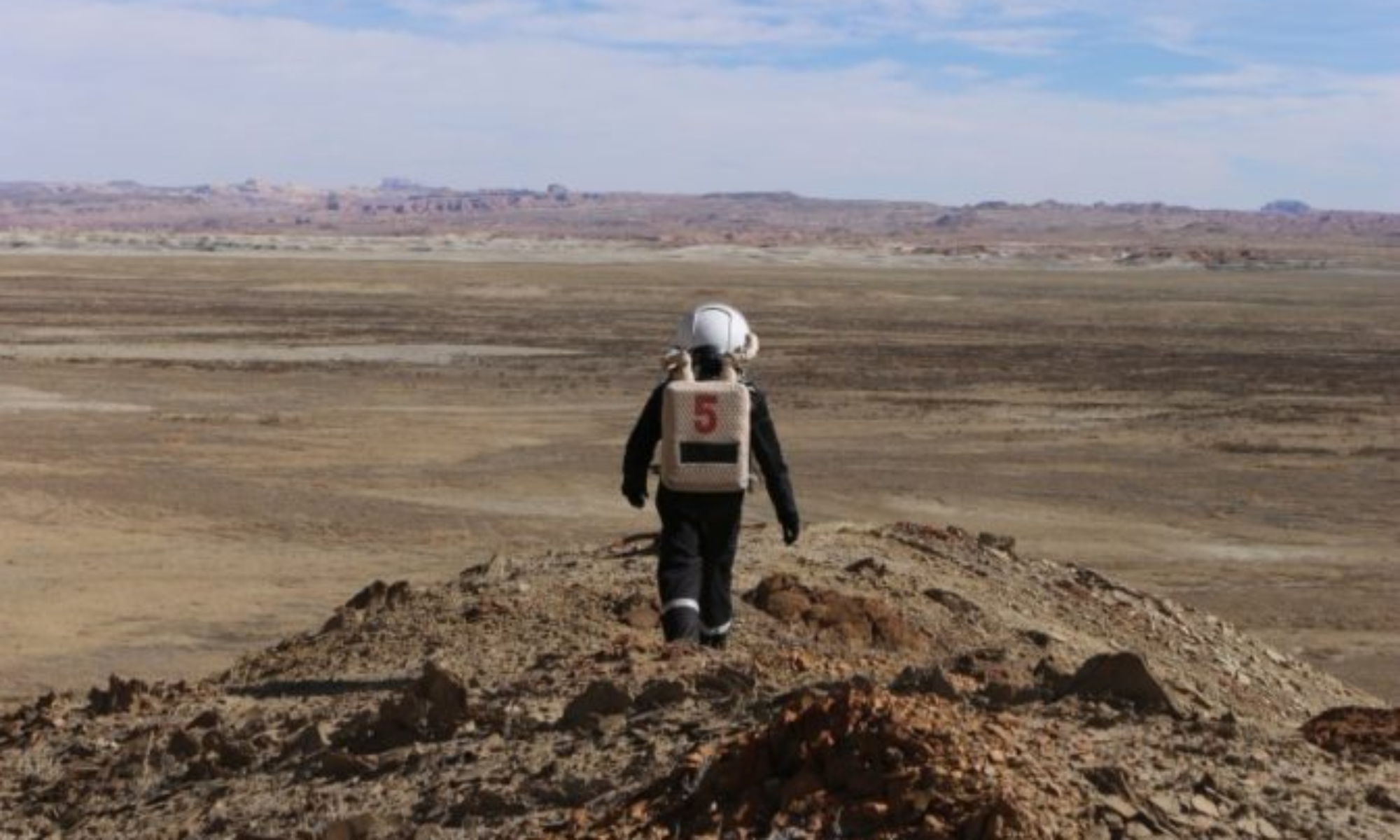
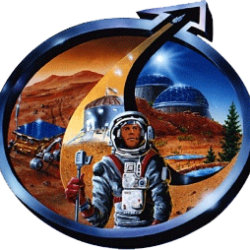


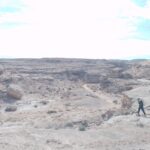
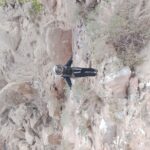
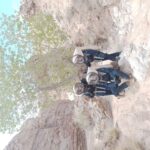
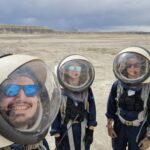
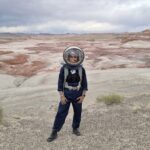
You must be logged in to post a comment.